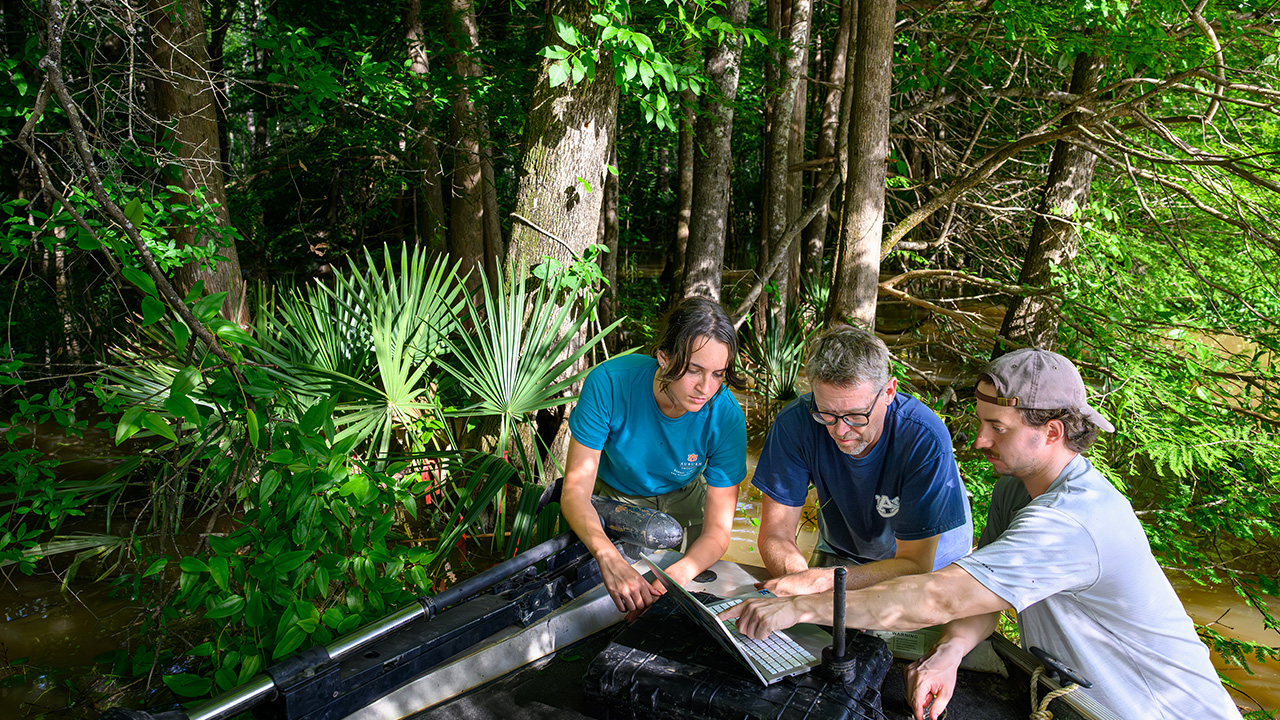content body
Ever wondered what it would be like to study in a sprawling and expansive wilderness? It may not be as far away as you think, as one of the most biodiverse regions in the United States is right here in Alabama.
Nicknamed “America’s Amazon,” the Mobile-Tensaw River Delta (MTRD) is the second largest delta in the contiguous United States and is home to a vast array of aquatic life, plants, trees and ecosystems.
The Wetland and Riparian Ecology Lab, housed in the College of Forestry, Wildlife and Environment, is dedicated to studying how changes in hydrology and surrounding land use can impact wetland function, with the MTRD serving as an important field site.

Nicknamed “America’s Amazon,” the Mobile-Tensaw River Delta (MTRD) is the second largest delta in the contiguous United States.
“The state of Alabama is among the most biodiverse states in the nation, particularly in terms of aquatic species,” said Professor Chris Anderson, director of the lab. “The delta is a major contributor to that.”
Creating change
Despite the MTRD being a hotspot of biodiversity on both the regional and national levels, the area is often overlooked.
“The MTRD is relatively understudied compared to similar systems,” said Andrew Balder, a graduate research assistant advised by Anderson who is pursuing a doctorate in forestry. “Alabama, in general, is such an understudied region, and coastal Alabama especially is being urbanized and developed at such a rapid pace. It’s important to study the land and figure out how to balance that economic development with environmental protection.”
Finding that balance is what motivates the lab to collaborate with external partners.
“My research usually has an implication for policy or wetland management,” Anderson said. “We want to provide information that helps inform decision-makers.”
With major cities like Mobile being so close to the delta, it is essential that strategies for responsible development are implemented.
“It’s tragic to see the environmental damage to the area, but the lab’s research ultimately serves the purpose of figuring out how we can better manage this area moving forward,” Balder said. “We can’t fix the past, but we can help landowners and government agencies manage our land for the future.”
Making mentors
Brianna Travis, a senior majoring in environmental conservation and management, works in the lab as an undergraduate research assistant. She collaborates with both Balder and Anderson, who she says have a passion for research that’s hard not to imitate.
“When I did field work with the lab, both Andrew and Dr. Anderson were so passionate about the MTRD, and they encouraged me to be hands-on with my learning,” Travis said. “From that moment on, I realized that the delta is such an important, beautiful place and that I care about this too.”
For Anderson, it all ties back to his experience as a student.
“I think a lot of faculty members say this, and it’s true — we feel like we’re paying it forward,” Anderson said. “Many of us are here because of the mentorship we got as students.”
That’s one hypothesis Anderson can count as tested and true.

Students who want to get involved with coastal issues have plenty of options, including classes, research opportunities and unique extracurricular programs.
“The mentorship I’ve received from Dr. Anderson has completely changed my whole college experience,” Travis said. “I’m excited to continue my work and someday pass on that same kind of mentorship.”
Want to get involved?
Fortunately, there are several options available for students wanting to get involved with coastal issues.
Students interested in gaining research experience may participate in Anderson’s lab or one of the many others that are working along the Gulf Coast. Auburn is also a member of the Marine Environmental Sciences Consortium, which allows students to take classes at the Dauphin Island Sea Lab in coastal Alabama.
In addition to research and classes, there are various student programs focused on the Gulf, such as the Gulf Scholars Program. Benefits of becoming a Gulf Scholar include pairing with a community partner to develop a Gulf-impact project, recognition from the National Academies of Science, Engineering and Medicine, leadership workshops and a weekend field excursion to the Gulf Coast.
Students interested in design-oriented careers may also be interested in the Gulf Adaptation Design Studio, an interdisciplinary collaboration that works on innovative design solutions to the environmental challenges along the coast.
Both of these programs will be recruiting new students in the spring.
“Once I got out in the field, I was blown away by how beautiful it is,” Travis said. “There really is nothing like it. Pictures don’t do it justice.”







